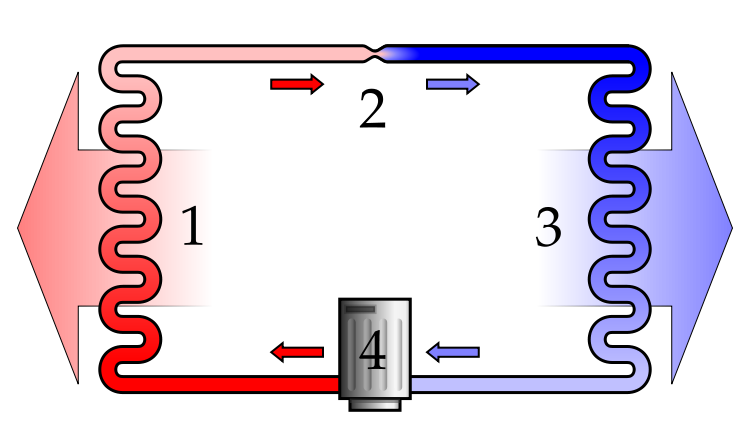How does a Split System work?


How does a Split System Work?
Split system air conditioners operate on a vapour compression refrigeration cycle.
Vapour compression involves a thermodynamic process of a refrigerant (for example R32, R410A or R22) changing state (from a liquid to a vapour and then back to a liquid again) which enables the air conditioner to absorb and reject heat.
Please see a diagram of a typical vapour compression refrigeration system below, where the components are numbered:
- Condensing Coil & Fan (outdoor unit)
- Thermal Expansion Valve (inline component of refrigeration system)
- Evaporator Coil and Fan (indoor unit)
- Compressor (inline component of refrigeration system)

1. Super Heated Vapour & the Condenser.
We will start this example as refrigerant comes out of the compressor (which is indicated as '4' on the diagram) and refrigerant is red and flowing to the left. This red space is where refrigerant comes out of the compressor, as a 'superheated' vapour.
Superheated means that the refrigerant is at a temperature that is higher than it's boiling point. (Similar to steam being hotter temperature to boiling water).
The superheated vapour moves to the condensing coils (No. 1 on the left of the diagram), which is a long, serpentine coil, which has a fan blowing over the coils. As the fan blows air over the condensing coils, heat is released out of the refrigerant into the ambient (outside air) and when the refrigerant achieves a constant temperature and pressure, it to change state, from a superheated vapour, to a 'subcooled' liquid.
2. Thermal Expansion Valve.
When the subcooled refrigerant reaches the indoor unit, it reaches an important component in the refrigeration system called a 'Thermal Expansion Valve' (or 'TXV' - labelled at the top of the diagram as '2').
The TXV has a thermostat connected of the evaporator, which tells it how much refrigerant is required to maintain the temperature of air over the evaporator coil. Based on the thermal load, the TXV will open and close to regulate the amount of liquid refrigerant which flows into the evaporator.
When refrigerant flows through the TXV, it experiences an abrupt pressure drop. This abrupt loss of pressure causes flash evaporation of some of the refrigerant and lowers the temperature of the refrigerant and it changes state from a subcooled liquid into a subcooled, saturated vapour.
3. Saturated Vapour and the evaporator
As the saturated vapour travels through the evaporator coil (indicated on the right of the diagram as '3'), the evaporator fan (also known as the indoor unit fan) sucks air over the coil and the refrigerant absorbs the heat out out of the air as it passes through the coil. This heat exchange causes the temperature of the refrigerant to go up (the refrigerant boils and evaporates into a saturated vapour) and the temperature of the air to go down. The cooled air is then blown through the louvres of the air conditioner back into the space.
To give an example of why refrigerants are used in air conditioners, a common refrigerant used in split systems is called 'R32'. R32 boils at -52 °C, so as long as the indoor air temp is above -52 °C, the air conditioner will still absorb heat.
4. The Compressor
The compressor (numbered 4 at the bottom of the diagram) sucks the saturated vapour out of the evaporator and into a compression chamber. There are 5 types of compressors commonly used in air conditioning systems, they are:
- Reciprocating Compressor.
- Scroll Compressor.
- Screw Compressor.
- Rotary Compressor.
- Centrifugal Compressor.
There is no hard and fast way to say one type of compressor is better than another, as each brand uses one the compressor type that matches their own proprietary technology and the capacity load of the air conditioning system. The compressor will compress the vapour until it reaches higher pressure and temperature, ready to be released back into the system as a superheated vapour.
The Cycle Continues
The superheated vapour then travels into the condenser (labelled as '1' in the diagram) and the cycle continues. As you can see, there are not a lot of components inside of the actual refrigeration system - a lot of the mechanical work is done by natural enthalpy.
However if you are reading about refrigeration for the first time and it does not make sense yet, please note that it took a colleague of the author who has a Ph.D in Plasma Physics, Magnetohydrodynamics & Astrophysics around a year to get his head around vapour compression refrigeration... so don't worry if it does not make a lot of sense right now. Come back and read this article again sometime!
If you would like to research more on the matter, please follow the links to the following Wikipedia documents:
Contact Us!
At EZYAIR, we always endeavour to provide our customers with the most interesting and relevant information to help them to make an informed decision. If you would like more information on the subject above:
- Please contact us here
- Call 1300 EZYAIR (1300 399 247) Monday to Friday, 9 to 5pm.
Our friendly staff are waiting to assist you.

